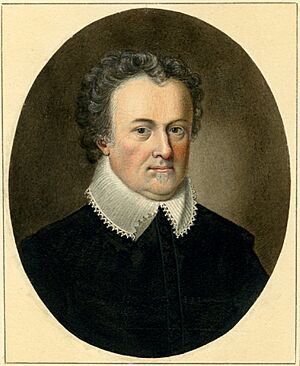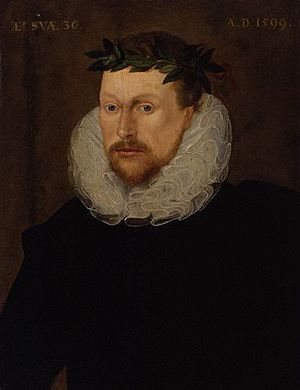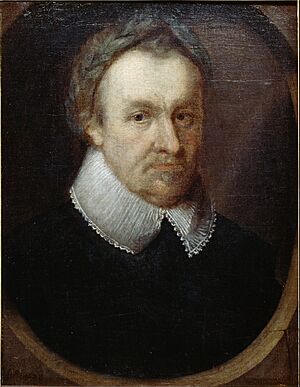Michael Drayton facts for kids
Michael Drayton (born 1563 – died 1631) was an English poet. He became famous during the time of Elizabeth I. He kept writing poems through the reigns of James I and Charles I. Many of his poems were about history. He was also the first English writer to create "odes" (a type of lyrical poem) like the Roman poet Horace. Michael Drayton passed away in London on December 23, 1631.
Contents
Michael Drayton's Early Life
Drayton was born in early 1563 in Hartshill, near Nuneaton, Warwickshire, England. We do not know much about his early years. In 1580, he worked for Thomas Goodere. It is thought that Sir Henry Goodere helped Drayton get an education. Some people used to think Drayton went to University of Oxford. However, newer studies suggest his family was not as high in social status as other famous poets like William Shakespeare.
Drayton's Writing Career
First Poems (1590–1602)
In 1590, Drayton published his first book, The Harmony of the Church. This book was full of spiritual poems. It included a special version of the Song of Solomon. Most copies of this book were destroyed by public order. Still, Drayton published many more works in the following years.
In 1593, he released Idea: The Shepherd's Garland. This was a collection of nine pastoral poems. In these poems, he wrote about his own love troubles. He used the name Rowland for himself. Drayton then wrote more "Idea" poems. These included 51 sonnets (a type of 14-line poem) called Ideas Mirrour (1594). This collection was later changed and expanded. Some people thought these poems meant he never married.
Drayton's sonnets are known for being simple and easy to understand. He also helped make the word "ode" popular in England for a lyrical poem.
Also in 1593, Drayton published his first historical poem, The Legend of Piers Gaveston. The next year, he released Matilda, a long poem about history. Around this time, he also wrote Endimion and Phoebe. This book was never republished. It contained some interesting details about his life. It also showed he got writing help from Thomas Lodge.
In 1596, Drayton published Mortimeriados, a serious historical poem. He later changed this poem and republished it as The Barons' Wars in 1603. Another historical poem, The Legend of Robert, Duke of Normandy, also came out in 1596. In 1597, he published England's Heroical Epistles. These were historical stories written like those by the Roman poet Ovid. These poems are considered some of Drayton's best writings.
Later Works (1603–1631)
By 1597, Drayton was quite famous. He was liked by Elizabeth I's court. He hoped for the same from the new king, James I. In 1603, he wrote a poem for King James. But the king did not like it, and Drayton was rejected. He showed his unhappiness in a poem called The Owl (1604). However, he was not very good at writing this type of poem. He also wrote a long poem about Moses in 1604.
In 1605, Drayton republished his most important works. These included his historical poems and the Idea collection. He also gathered his shorter poems into a book called Poems Lyric and Pastoral. This book included odes, eclogues (poems about country life), and a funny poem called The Man in the Moon. Some of his odes are very lively.
Around 1598, Drayton decided to write about all the interesting places in Great Britain. He worked on this huge project for many years. Finally, in 1613, the first part of this work was published. It was called Poly-Olbion. It had eighteen books, and the scholar John Selden added notes.
This big work was not very popular at first. It was not until 1622 that Drayton found a publisher for the next twelve books. This finished the survey of England. Drayton had wanted to write about Scotland too, but he never did.
In 1627, he published another collection of poems. This book included some of his most famous writings. It had The Battle of Agincourt, a historical poem. It also had The Miseries of Queen Margaret. Another poem was Nimphidia, the Court of Faery, which was an epic about fairyland. The Quest of Cinthia and The Shepherd's Sirena were lyrical poems. Finally, there was The Moon Calf, a type of satire. Nimphidia and his ballad about the battle of Agincourt are very well-known.
Drayton's last big publication was The Muses' Elizium in 1630. He died in London. He was buried in Poets' Corner in Westminster Abbey. A monument was placed there for him by the Countess of Dorset. The famous writer Ben Jonson is thought to have written the lines on his monument.
Drayton and Theatre
Like other poets, Drayton also wrote for the theatre. But he did not put as much effort into plays as William Shakespeare or Ben Jonson. For about five years, from 1597 to 1602, Drayton worked for Philip Henslowe. Henslowe's diary shows Drayton was involved in 23 plays during this time. He almost always worked with other writers like Thomas Dekker and Anthony Munday.
Only one of these 23 plays still exists: Part 1 of Sir John Oldcastle. Drayton wrote this play with Munday, Robert Wilson, and Richard Hathwaye. It is not clear how much Drayton wrote in this play.
Drayton might have preferred being a theatre manager. He was one of the people who rented the Whitefriars Theatre when it opened in 1608. Around 1606, Drayton also helped start a company of child actors. This group was not successful and ended in 1609.
Drayton's Friends
Drayton was friends with many famous people of his time. He wrote letters to Drummond. Ben Jonson, William Browne, and George Wither were also his friends. A vicar named John Ward wrote that "Shakespear Drayton and Ben Jhonson (sic) had a merry meeting and it seems drank too hard for Shakespear died of a feavour there contracted." This means Shakespeare, Drayton, and Ben Jonson had a fun gathering. It is said Shakespeare got a fever there and later passed away.
In one of Drayton's poems, he wrote about English poets from Chaucer's time to his own. This included Shakespeare. From his own words, we can tell Drayton was sometimes restless and unhappy, but also a good person.

Collected Works
In 1748, a large collection of Drayton's complete works was published. Later, in the 20th century, more complete editions of his poems were published. These include a five-volume set from Oxford (1931–41) and a two-volume set from Harvard (1953).
See also
 In Spanish: Michael Drayton para niños
In Spanish: Michael Drayton para niños



